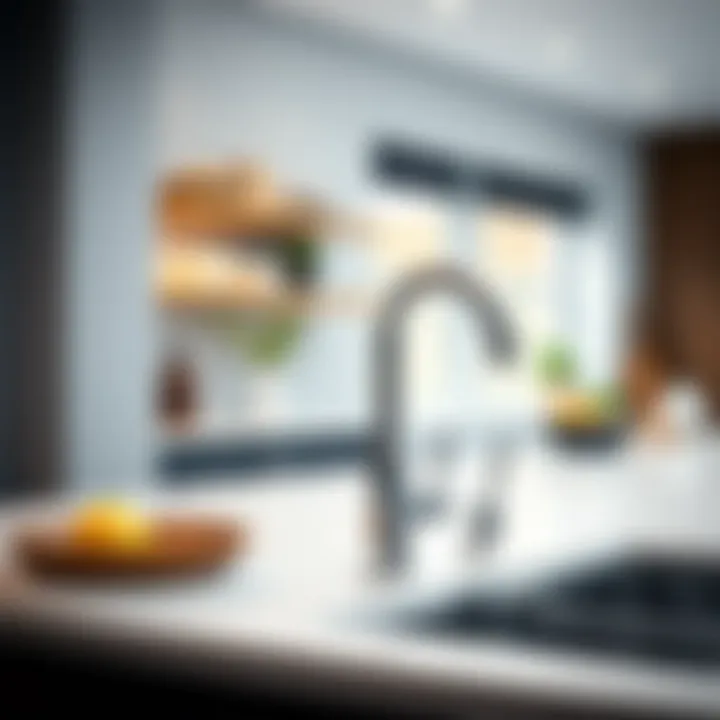Complete Guide to Choosing Kitchen Tapware


Intro
In the heart of every home, the kitchen serves as far more than just a place to cook. It's the backdrop for countless memories, a hub of activity, and often, a first impression for guests. Tapware, though frequently overlooked, plays a pivotal role in both the functionality and aesthetic appeal of this essential space. Understanding the various types, materials, and styles of kitchen tapware not only enhances your kitchen's appearance but can also significantly affect your home's value and your daily life.
Importance of Kitchen Tapware
A good quality kitchen tap can transform not just the look but the way you interact with your kitchen. From sleek modern designs to rustic vintage styles, the right tapware combines practicality with visual appeal. The evolution in designs reflects current trends, shifting towards sustainability and innovative technology. These faucets are no longer just tools; they are statements of personal style.
As you embark on this comprehensive guide to kitchen tapware, we will explore the myriad options available. Whether you're a homeowner looking to upgrade, a designer aiming for the latest trends, or a DIY enthusiast eager for maintenance tips, this guide aims to arm you with relevant knowledge. Let’s dive deeper into what’s trending in the world of kitchen tapware.
Understanding Kitchen Tapware
Kitchen tapware plays an essential role in both functionality and design in modern homes. It's not just about turning the water on and off; it’s about how these fixtures complement your kitchen's aesthetics and improve user experience. The significance of understanding kitchen tapware cannot be understated, particularly when one considers the variety of options available that cater to differing styles, needs, and preferences.
In this article, we will delve into various aspects of kitchen tapware, focusing on the benefits and considerations you should keep in mind. Choosing the right tap can significantly enhance the efficiency of your kitchen tasks, from washing fruits and vegetables to filling pots for cooking. It’s about creating a blend of practicality and style that resonates with your personal taste. The right tapware can also conserve water, aligning with eco-friendly practices without compromising style.
Definition and Importance
So, what exactly do we mean by kitchen tapware? Simply put, it refers to the various faucet styles and fittings used in kitchen sinks. This includes everything from standard faucets to high-tech options with smart features that adjust water flow based on your needs. Its importance transcends mere utility; it plays a pivotal role in defining the overall vibe of your kitchen. Just like how a well-chosen piece of artwork can elevate a room, a stylish faucet can serve as a centerpiece that completes your kitchen’s look.
Tapware is typically made from various materials, each presenting its own benefits and drawbacks, which become essential elements to consider during selection. Durability, ease of cleaning, aesthetics, and most importantly, your preferred ergonomic experience often dictate which tapware suits your kitchen best. Thus, getting a clear understanding of kitchen tapware is pivotal as it dictates both the functionality of your kitchen space and its visual appeal.
Historical Evolution of Tapware
The story of kitchen tapware is a fascinating journey through time, revealing how this simple fixture has significantly evolved over the years. Historically, taps were rudimentary, often fashioned from materials like wood or basic metals that could deteriorate with age. For centuries, the plumbing systems were rudimentary at best, often relying on buckets and wells instead of fixed taps. It was only with the advent of modern plumbing in the 19th century that tapware as we know it began to emerge.
In the early 20th century, materials like brass and chrome became popular, not only for their durability but also for their stylish finish. Taps started to become an important design element in kitchens. Fast forward to the 21st century, and the landscape has changed dramatically. Today's kitchen tapware ranges from minimalist designs to luxurious, multifunctional fixtures that reflect personal styles.
Through the decades, advancements in technology have introduced features like touchless activation and water-saving technologies, showcasing a clear shift toward efficiency and user comfort. Each phase in the evolution of kitchen tapware highlights a growing awareness among consumers regarding both functionality and style, as well as an understanding of sustainable usage.
In summary, grasping the historical context of kitchen tapware can offer valuable insights into modern selections. It showcases not just trends, but also allows you to appreciate the intricate blend of industrial design, practicality, and user engagement that governs today’s choices in fixtures.
"The essence of kitchen tapware goes beyond mere water delivery; it’s a dance of form and function."
This understanding is crucial for making informed decisions when selecting your kitchen tapware, ensuring it serves both your functional needs and aesthetic aspirations.
Types of Kitchen Tapware
Understanding the various types of kitchen tapware is crucial for homeowners, designers, and DIY enthusiasts alike. Each type of faucet serves its purpose, combining functionality with aesthetics. Selecting the right tapware can enhance one’s kitchen experience, whether it be through ease of use, water efficiency, or complementing the overall decor. Different styles come with their unique benefits and considerations that affect utility and design. Knowing these distinctions helps in making an informed choice that aligns with both practical needs and personal style.
Single-Handle Faucets
Single-handle faucets are the epitome of simplicity and ease. They allow users to control both water flow and temperature with one hand, making them especially handy when your other hand is full or dirty. These faucets often come with a sleek, minimalist design that can easily fit into various kitchen styles—from modern to traditional.
- Advantages: A single-handle design means less clutter and easier cleaning around the sink area. This type is also usually easier to install compared to dual-handle counterparts.
- Considerations: Limited precision in temperature control can be a concern. Some users find it tricky to get the perfect mix, especially when filling pots or kettles where hot water is needed quickly.
Dual-Handle Faucets
If you cherish the classic feel of the kitchen, dual-handle faucets might be up your alley. These installations typically feature separate handles for hot and cold water, enabling precise temperature adjustments. This feature can be particularly appealing for those who appreciate a traditional and timeless aesthetic in their space.
- Advantages: Offers optimal control over water temperature and flow, allowing for a more customized experience. The design also invokes a sense of craftsmanship that resonates well in traditional-style kitchens.
- Considerations: Slightly more complex to install, they may pose a challenge for DIY enthusiasts. Additionally, they need more space, which may not suit smaller sinks very well.
Pull-Down and Pull-Out Faucets
Versatility is the name of the game when it comes to pull-down and pull-out faucets. These taps come equipped with a sprayer that can be pulled down or out, allowing users to reach every nook and cranny of the sink and beyond. Perfect for both rinsing vegetables and washing dishes, they add functionality to the kitchen like a charm.
- Advantages: Perfect for multitasking, as they can easily switch from a steady stream to a powerful spray. This flexibility often makes them ideal for those who frequently cook and clean.
- Considerations: They may take up more space than a standard faucet and can require more maintenance to keep the pull-out feature operating smoothly.
Commercial-Style Faucets
If you're someone who enjoys cooking or if you want your kitchen to have a professional flair, commercial-style faucets are worth considering. These faucets mimic the kind used in restaurants, featuring a high spout and often, a spray nozzle. Not only do they bring a certain robustness to the kitchen, but they also work wonders for large sinks.
- Advantages: Designed for heavy use, these fixtures typically offer superior durability and functionality. They often come equipped with additional features like a pot filler or side sprayer.
- Considerations: While they look impressive, they might overwhelm smaller kitchen spaces. Their installation often requires familiarity with plumbing guidelines.
Motion-Sensor Faucets
In an era where technology meets everyday life, motion-sensor faucets stand out as convenient and modern replacements for traditional options. These faucets detect hand movements, which means you no longer have to touch the handles to get water. This makes them particularly useful in environments where hygiene is paramount.


- Advantages: They minimize cross-contamination and are perfect for those with busy kitchens. These faucets can also help save water, as they automatically turn off when not in use.
- Considerations: Installation can be more complex due to the need for sensors and power sources. Maintenance is also crucial to ensure sensors function correctly, and they may require battery replacements or additional electrical setup.
Choosing the right type of kitchen tapware is essential to achieving both functionality and aesthetics in your kitchen space. Proper consideration of your needs will steer you in the right direction.
Material Considerations
When selecting kitchen tapware, the material from which it is made plays a pivotal role not just in aesthetics but in functionality, durability, and ease of maintenance. Understanding the various materials helps homeowners and designers make well-informed choices that suit their individual needs. Let’s decode why material choice is crucial and explore the three prominent types: stainless steel, bronze and brass, and plastic and composite materials.
Stainless Steel
Stainless steel is a favored choice for kitchen tapware due to its robust nature and modern appeal. This material is known for its resistance to corrosion, stains, and rust, making it ideal for environments exposed to moisture. Homeowners appreciate the fact that it’s easy to clean, requiring only a quick wipe with a damp cloth and mild detergent to maintain its shine.
Moreover, stainless steel has a sleek, contemporary look that aligns well with various kitchen styles, from minimalist to industrial. However, one should be mindful of the potential for scratching. That said, many manufacturers treat stainless steel taps with special coatings to enhance scratch resistance.
Bronze and Brass
Bronze and brass tapware gives a warm, classic touch that can transform a kitchen into a timeless space. These materials, particularly bronze, possess inherent antibacterial properties, making them a hygienic option. Over time, they develop a unique patina, adding character and aesthetic charm that many homeowners find appealing.
While bronze and brass taps can be a bit pricier, they offer incredible durability. It's essential to consider the maintenance aspect, as these materials may tarnish and require polishing to keep them looking their best. Despite this, their visual appeal often far outweighs the extra effort required to maintain their luster.
Plastic and Composite Materials
Plastic tapware has evolved significantly, and with advances in technology, composite materials have emerged as viable options in kitchen designs. These materials are lightweight and often come in a variety of colors and finishes, allowing for excellent customization to match or contrast with existing decor.
Although plastic and composites may not have the same level of durability as metals, they are less susceptible to corrosion and often resistant to impact. This can be particularly appealing in households with kids or in environments where durability is paramount. However, it’s wise to avoid low-quality plastics that may leach chemicals or succumb to wear and tear more quickly.
In summary, the choice of material for kitchen tapware is not merely a matter of preference but encompasses factors like durability, maintenance, and aesthetic compatibility. The materials selected can significantly influence the overall ambiance and functionality of the kitchen, making it essential to choose wisely.
"The right material can bring both beauty and practicality; it’s all about choosing what aligns with your lifestyle and kitchen vision."
For more detailed information on different tapware materials, visit Wikipedia or explore insightful articles on Britannica.
Design and Style Trends
The aesthetics of a kitchen can dictate the entire ambiance of the home. When it comes to kitchen tapware, design and style trends play a pivotal role in harmonizing functionality with visual appeal. Homeowners and designers alike are now placing significant emphasis on choosing tapware that not only serves its purpose but also elevates the overall look of the space. This section delves into the important trends shaping kitchen tapware design, highlighting how these choices reflect personal style and contribute to the kitchen's atmosphere.
Sleek Modern Designs
In today’s fast-paced world, sleek modern designs are all the rage. These tapware pieces often feature clean lines and minimalist silhouettes that resonate well with contemporary design philosophy. The beauty of modern designs lies in their ability to offer high functionality wrapped in aesthetic simplicity. Tapware like the Delta Trinsic collection, for instance, showcases this concept perfectly.
- Materials: Predominantly made from stainless steel or chrome, these materials add a polished finish that enhances durability while still looking chic.
- Ergonomics: The smooth operation and comfortable handling of modern faucets often come equipped with features such as pull-down sprayers or touch controls, making cooking and cleaning tasks easier and more efficient.
An important consideration for modern designs is coherence with other kitchen elements—appliances, cabinetry, and even the countertops should harmonize with the faucet choice. Every detail counts, and mismatched finishes can disrupt the overall stylish vibe.
Vintage and Traditional Aesthetics
While modern designs are popular, vintage and traditional styles are firmly holding their ground. These designs evoke nostalgia and comfort, often reminding individuals of a time when craftsmanship was paramount. Traditional tapware tends to feature intricate detailing, including porcelain handles and elaborate designs, like those seen in the Kohler K-8100-2-CP.
- Craftsmanship: Handcrafted elements become appealing to those looking for uniqueness, as each piece tells a story.
- Character: This style adds character to kitchen settings, creating warm, inviting environments that encourage family gatherings and social interactions.
Functionality and Features
When it comes to kitchen tapware, functionality is the lifeblood that keeps the kitchen running smoothly. It’s not just about aesthetics anymore; today’s homeowners expect their tapware to enhance both convenience and usability. A kitchen tap isn’t simply where water flows from; it’s a workspace ally, bridging the gap between cooking, cleaning, and food prep. This section dives deep into three specific features that are revolutionizing the way we interact with our kitchens: water flow technology, eco-friendly water use, and temperature control innovations.
Water Flow Technology
Water flow technology is at the heart of modern tapware design. It’s all about managing how water flows from your faucet to your dishes—in style. Brands today are developing faucets that offer adjustable flow rates, allowing you to switch between a powerful spray for washing pots and a gentle stream for filling glasses. Some faucets come equipped with aerators, which mix air with water, giving you a strong spray while using less water.
The real magic might be the touch technology; just a tap with your wrist or forearm can turn the water on and off. This is not just convenient when your hands are full but also reduces the risk of cross-contamination when prepping food.
Key Benefits of Advanced Water Flow Technology:
- Versatility: Adapt your water flow for various tasks, from rinsing produce to washing dishes.
- Efficiency: Save on water usage while maintaining powerful spray, thanks to innovative aeration.
- Convenience: Touch and motion-sensitive options simplify daily tasks.
Eco-Friendly Water Use
Sustainability is an ever-growing concern, and kitchen tapware is no exception. Eco-friendly designs are becoming more prevalent as consumers demand products that help them conserve water. Many modern faucets feature flow restrictors that limit the amount of water used without sacrificing performance. This is often measured in gallons per minute (GPM), with some innovative designs allowing for flows as low as 1.5 GPM, which is a significant reduction compared to older models.
Moreover, some taps feature smart sensors, which can detect when you need water and lessen unnecessary flow. Not only does this save water, but it also saves money on utility bills in the long run. Choosing tapware with eco-friendly features shows respect for the environment and contributes to a more sustainable future.


Considerations for Eco-Friendly Choices:
- Look for WaterSense or similar certification: These faucets meet strict water efficiency criteria.
- Evaluate installation: Proper installation can enhance efficiency—consider that when purchasing new tapware.
Temperature Control Innovations
Nothing can ruin a cooking experience faster than poor temperature control when it comes to water for rinsing or cooking. New technology in kitchen tapware has turned this inconvenience into a thing of the past. Many faucets now come with built-in thermostatic controls that help maintain your desired water temperature, eliminating the guessing game with the hot and cold knobs. This leads to less scalding or freezing incidents.
Some manufacturers have even taken it a step further—touchless taps with temperature memory features allow users to set their preferred temperature for a seamless experience. Imagine not having to adjust the handles every time you wash your vegetables or fill a pot to boil.
Innovations in Temperature Control Include:
- Thermostatic mixing valves: These keep the water at safe temperatures automatically.
- Touchless controls: Adjust temperature quickly without the need to touch the faucet at all.
"Modern kitchen tapware is as much about function as it is about form—today's designs cater to both utility and style, making every drop count."
For more in-depth knowledge, you can visit websites like WaterSense or The American Standard which offer a wealth of information on eco-friendly water solutions.
Installation Considerations
When it comes to upgrading or replacing kitchen tapware, installation considerations are paramount. A kitchen faucet is more than just a fixture; it's the heart of your culinary space, influencing both functionality and aesthetics. Whether you're a weekend warrior in DIY projects or someone who opts for professional help, the installation process impacts longevity, efficiency, and ease of use.
Professional Installation vs. DIY
Choosing between professional installation and taking on the task yourself depends on various factors, including skill level, time constraints, and the nature of the plumbing setup.
- Professional Installation: Hiring a licensed plumber comes with a host of benefits. These experts bring years of experience, ensuring that the installation adheres to local codes and plumbing standards. This option is especially wise if your kitchen's plumbing system is outdated or has special requirements like rerouting pipes. Professionals often provide warranties on their labor, offering you peace of mind.
- DIY Installation: For the handy homeowner, DIY installation can lead to significant cost savings. If you're confident with a wrench and some basic plumbing knowledge, tackling a faucet swap may feel like a breeze. That said, it's critical to read the manufacturer's instructions carefully, as every model comes with its unique nuances. Also, keep in mind that mistakes can lead to leaks or other complications down the line.
"Whether you're going pro or doing it yourself, understanding your tapware's installation needs is key to a flawless finish."
Plumbing Requirements
Understanding the plumbing requirements is essential when selecting new kitchen tapware. Here are critical points to consider:
- Water Supply Lines: Ensure that the supply lines are compatible with your new faucet. Most kitchen faucets require a standard 3/8-inch connection. If your supply lines are outdated or mismatched, you might need to replace them, which could involve additional costs.
- Drainage System: Make sure your drainage setup can handle the flow and design of your chosen tapware. An improper drainage system can lead to flooding or other plumbing headaches.
- Pressure and Flow Rates: Familiarize yourself with your home's water pressure. High-pressure systems may necessitate specialized faucets to prevent water waste or splashing. Moreover, understanding the flow rate ensures that you purchase a faucet that meets your cooking and cleaning needs without being wasteful.
- Access Points: Consider the accessibility of plumbing under the sink. If it's cramped or difficult to work in, hiring a professional might save you from a lot of headaches.
Focusing on these installation concerns not only enhances the functionality of your kitchen tapware but also ensures a seamless upgrade that integrates beautifully with your kitchen's overall design. Proper installation sets the stage for ease of use and long-lasting performance.
Maintenance Tips
Maintaining your kitchen tapware is crucial for both aesthetics and functionality. A well-cared-for faucet not only enhances the overall look of your kitchen but also ensures smooth operation over the years. Ignoring maintenance can lead to a slew of issues, such as leaks, poor water flow, or even complete dysfunction of the tap. Therefore, it's not merely about keeping your tapware shiny; it’s about prolonging its life and performance.
Regular Cleaning Practices
You might think that a quick wipe with a sponge once in a while will do the trick, but regular cleaning necessitates a bit more effort. Ideally, you should clean your tapware every week to remove water spots, grease, and soap scum that can accumulate quickly. Here’s how to go about it:
- Use a soft cloth or sponge to avoid scratching the surface.
- Mix a mild dish soap with warm water for a gentle yet effective solution.
- For tougher stains, a vinegar-water solution can work wonders and is eco-friendly!
- Don't forget to clean the aerator too, as it can accumulate debris leading to reduced water flow.
Given the variety of materials in kitchen tapware, be sure to check manufacturer guidelines as some finishes like brushed nickel or chrome can require special care. Essentially, keeping your tap clean ensures that it's not just pleasing to the eye, but functional too.
Preventing Mineral Buildup
If you live in an area with hard water, mineral buildup can be an all-too-real problem. Over time, those pesky deposits can clog aerators and diminish water flow, leading to frustration in the kitchen. Regular checks and preventive measures can save you a heap of hassle down the road. Here’s what you can do:
- Install a water softener if hard water is a persistent issue.
- Soak the aerator in vinegar every month for about an hour to break down any deposits.
- Rinse with warm water and reattach to your tap. Simple and effective.
By taking these small steps, you'll not only maintain the functionality of your tapware but also extend its lifespan considerably.
When to Replace Your Tapware
Knowing when it’s time to wave goodbye to your old tapware can be tricky. However, tend to rely on these indicators:
- Frequent leaks are a telltale sign. If you've been tightening that knob more times than you can count, it might be time for a change.
- A significant reduction in water flow can indicate internal damage or buildup that isn't easily resolved through cleaning.
- Aesthetics matter too; if your tap looks dented or discolored, it might just detract from your kitchen's overall charm.
Remember that tapware can be a worthwhile investment. If your current models don't meet your needs for style or functionality, it might be worth considering a replacement.
"The right tapware can elevate your kitchen from mundane to magnificent. Don't hesitate to upgrade when the time is right!"


Taking these maintenance tips to heart will go a long way in keeping your kitchen tapware in prime condition for years to come.
Top Brands in Kitchen Tapware
In the world of kitchen tapware, choosing a trusted brand can significantly enhance your experience and ensure longevity in your investment. Top brands in kitchen tapware are more than just names; they represent quality, innovation, and customer satisfaction. Opting for renowned manufacturers often brings peace of mind, as they are typically backed by years of expertise and a commitment to meeting the diverse needs of homeowners and designers alike. When considering a purchase, factors such as reliability, warranty terms, product range, and service post-purchase come to play, and top brands usually excel in these areas.
With an array of brands available in the market, discerning the right choice might seem daunting. However, focusing on a few leading manufacturers can streamline the process, guiding you toward high-quality options that fit your aesthetic and functional aspirations.
Overview of Leading Manufacturers
Several manufacturers stand out when it comes to kitchen tapware. These brands have carved niches for themselves through dedicated craftsmanship and innovative designs:
- Kohler: As a pioneer in bathroom and kitchen fixtures, Kohler is known for combining functionality with sophisticated design. Their products often feature modern technologies that appeal to the needs of modern homeowners.
- Moen: Known for its state-of-the-art innovations, Moen tapware often incorporates user-friendly features and timeless aesthetics. They have a strong focus on ease of use and customer satisfaction.
- Delta: Delta has cemented its reputation by crafting products that focus on water efficiency without sacrificing performance. They are particularly lauded for their ToucO® technology, allowing users to operate the faucet with a simple touch.
- Grohe: A European brand that emphasizes luxury and sustainability, Grohe faucets blend cutting-edge technology with exquisite design, catering to high-end kitchens and sophisticated consumers.
- Blanco: This brand specializes in kitchen sinks and faucets, embracing the principles of effective kitchen work and an elegant aesthetic. Blanco products are known for their quality materials and stylish designs.
These brands demonstrate how kitchen tapware can live up to both functional demands and style preferences, ensuring that when you invest in something from their line-up, you're making a choice rooted in quality.
Comparing Price Points and Quality
Price points for kitchen tapware can vary greatly depending on the manufacturer and features included. Analyzing the interplay between price and quality is crucial to making an informed purchasing decision. Here are some considerations:
- Budget Range:
- Quality Indicators:
- Entry-Level: Brands like Pfister or some models from Moen offer affordable yet stylish options, perfect for those on a budget.
- Mid-Range: Kohler and Delta provide excellent mid-range products that strike a balance between cost and innovative features.
- High-End: Kohler and Grohe produce premium options that come with the latest technology and luxury features, reflecting their price tags.
- Materials: Look out for tapware made of durable materials like brass with a high-quality finish, as they tend to resist wear and have better longevity.
- Warranty: A broader warranty often indicates confidence in product quality. Brands like Moen usually offer limited lifetime warranties on their products, reassuring you of their durability.
"Investing in quality kitchen tapware is not merely about aesthetics; it's also about functionality and peace of mind."
Sustainability in Tapware Choices
Sustainability has become a hot topic in recent years, especially in the realm of home improvement and design. When it comes to kitchen tapware, this importance is twofold. First, it’s about making a conscious choice that reduces environmental impact. Second, it revolves around picking fixtures that stand the test of time. Here, we’ll explore some specific elements, the benefits of sustainability in tapware, and key considerations to keep in mind.
The Importance of Sustainability
In the grand scheme of kitchen design, selecting sustainable tapware can have a significant impact. Tapware, being an integral part of our daily routines, consumes water and energy. The larger conversation on climate change and resource depletion heightens the urgency to make choices that reflect a commitment to sustainability.
- Resource Conservation: Opting for energy-efficient models helps conserve both water and energy. For instance, some models come with low-flow features which reduce water wastage without compromising on performance.
- Longevity and Quality: Sustainable tapware typically means better quality materials. Many manufacturers today focus on durable, high-quality materials that withstand wear and tear. This extends the lifespan of your kitchen fixtures, ultimately reducing the need for replacements.
- Health and Safety: Environmental sustainability is also a matter of health. Many traditional tapware designs are made with harmful chemicals like lead, which can leach into water. Sustainable options use safer materials which are less likely to pose a health risk.
"Every drop saved is a drop earned!"
Eco-Friendly Innovations in Tapware
The market is brimming with innovations that prioritize eco-friendliness. Manufacturers are keenly aware of the need to offer products that not only look good but also serve a higher purpose. Here are some noteworthy innovations:
- Touchless Faucets: These models use motion sensors to operate, reducing unnecessary water flow. They are particularly useful in minimizing waste during activities such as cooking or cleaning.
- Water-Efficient Technologies: Many modern taps now employ aeration technology, allowing for a high-pressure feel while using less water. This bridge between efficiency and performance is a game changer for eco-conscious homeowners.
- Recycled Materials: More companies are utilizing recycled metals and plastics in their manufacturing processes. These materials help reduce the mining and production footprint, which is a big step in the right direction.
- Smart Technology: With smart faucets, you can monitor your water usage through mobile apps, giving you significant insight into your consumption patterns. This data allows you to make revisions to your water usage, further enhancing your sustainability efforts.
By choosing tapware that is not only stylish but also sustainable, homeowners, designers, and DIY enthusiasts can contribute to a larger goal of protecting our planet. Making these informed choices today means a better tomorrow – for our kitchens, our homes, and the environment.
Future Trends in Kitchen Tapware
The realm of kitchen tapware is ever-evolving, reflecting the dynamic nature of home design and technology. Understanding future trends in tapware is essential for anyone looking to upgrade their kitchen or simply keep abreast of what’s coming down the pipeline. This segment focuses on pivotal elements that are shaping the tapware of tomorrow, detailing necessary considerations and the benefits that come with these advancements.
Smart Technology Integration
In today's fast-paced world, technology seeps into every corner of our lives, and the kitchen is no exception. Smart technology integration in kitchen tapware is becoming increasingly common, and its benefits cannot be overstated. Imagine being able to control your kitchen faucet hands-free. Devices have evolved to allow voice activation, enabling users to adjust water temperatures or volumes just by speaking. This innovation comes in particularly handy when your hands are full or dirty.
Moreover, the integration of sensors means water flow starts and stops automatically, which dramatically reduces waste. This clever touchless design is particularly beneficial for households with children or individuals who frequently juggle multiple tasks.
The implications go beyond mere convenience. Many smart faucets are now outfitted with features that track water usage, providing insights into consumption habits. For environmentally-conscious homeowners, this data can motivate more efficient water usage, ultimately benefiting both the planet and the monthly water bill.
"As we move forward, the confluence of sustainability and technology will redefine what we expect from kitchen fixtures."
Perhaps the most intriguing aspect of this trend is the possibility of app compatibility. Certain brands are working on designs that allow you to control settings via smartphone apps, giving users unprecedented power over their kitchen environment.
Design Influences Shaping the Future
Aesthetics play just as crucial a role in the future of kitchen tapware as functionality does. Design influences are shifting towards a blend of minimalism and vibrant customizations, appealing to the modern aesthetic sensibility. Homeowners are leaning away from purely functional designs and opting for pieces that also serve as statement features within their kitchens.
Emerging trends include:
- Sculptural Forms: Tapware is becoming more artful. Designers are creating faucets that double as sculptures, providing a touch of elegance and sophistication.
- Bold Colors and Textures: Gone are the days of plain chrome. As color trends make their seasonal rounds, expect to see bold blacks, deep greens, and even metallic finishes taking center stage.
- Eco-Conscious Designs: With environmental issues at the forefront of societal concerns, sustainable materials are making waves. Recycled metals and biodegradable options reflect a growing commitment to sustainability in design.
These design influences not only enhance the visual appeal of kitchens but also encourage homeowners to express their personality through their choices in tapware. The ability to harmonize aesthetic beauty with cutting-edge technology truly marks a new era in kitchen design, making this field of home improvement particularly exciting.
In summary, as we peer into the future of kitchen tapware, it's clear that we stand on the cusp of significant transformation. Smart technology improves functionality and efficiency, while innovative designs cater to ever-evolving tastes and eco-conscious values. Homeowners, designers, and DIY enthusiasts must keep these pieces in mind to stay ahead of the curve and create kitchens that are not only beautiful but also intelligent and sustainable.















